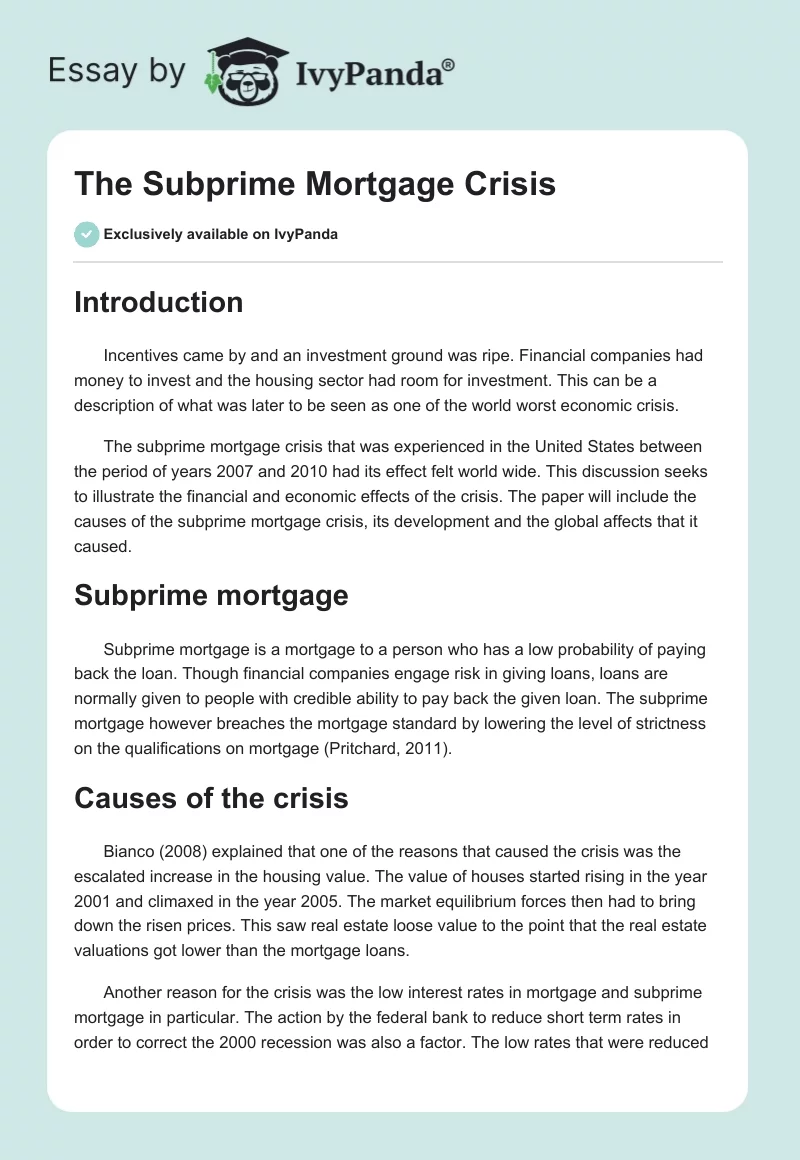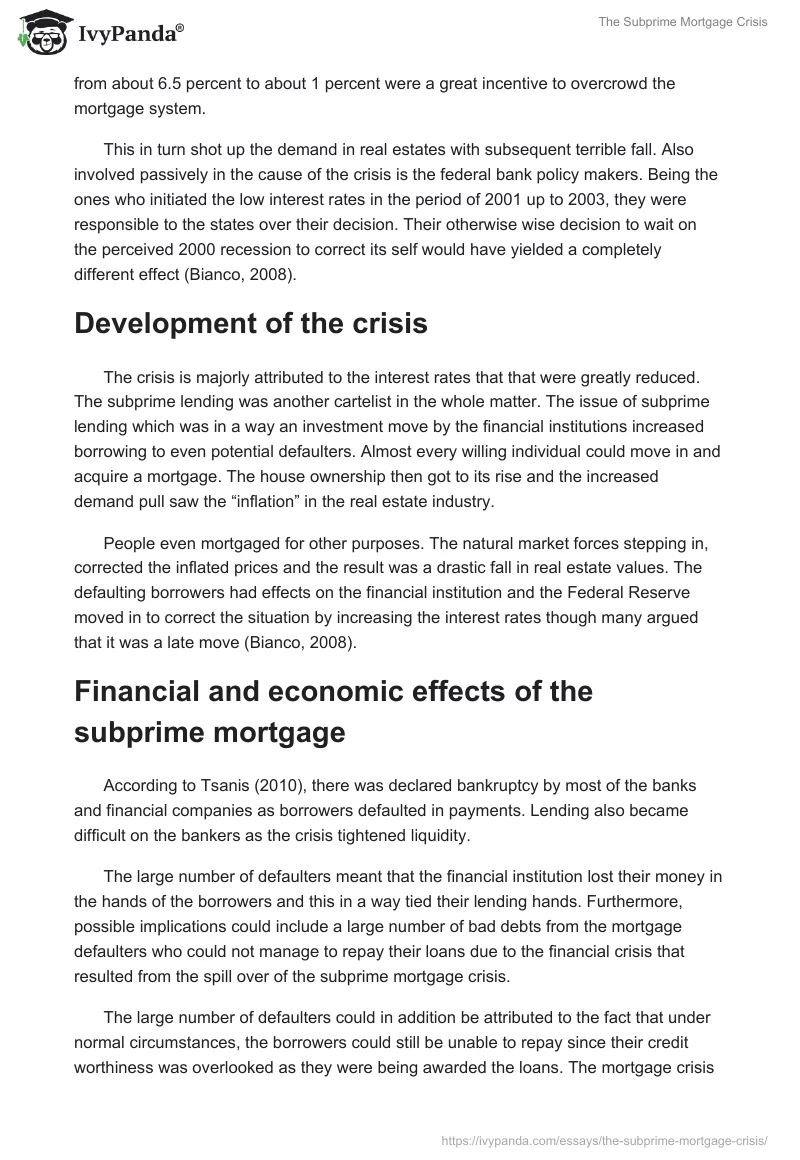Introduction
Incentives came by and an investment ground was ripe. Financial companies had money to invest and the housing sector had room for investment. This can be a description of what was later to be seen as one of the world worst economic crisis.
The subprime mortgage crisis that was experienced in the United States between the period of years 2007 and 2010 had its effect felt world wide. This discussion seeks to illustrate the financial and economic effects of the crisis. The paper will include the causes of the subprime mortgage crisis, its development and the global affects that it caused.
Subprime mortgage
Subprime mortgage is a mortgage to a person who has a low probability of paying back the loan. Though financial companies engage risk in giving loans, loans are normally given to people with credible ability to pay back the given loan. The subprime mortgage however breaches the mortgage standard by lowering the level of strictness on the qualifications on mortgage (Pritchard, 2011).
Causes of the crisis
Bianco (2008) explained that one of the reasons that caused the crisis was the escalated increase in the housing value. The value of houses started rising in the year 2001 and climaxed in the year 2005. The market equilibrium forces then had to bring down the risen prices. This saw real estate loose value to the point that the real estate valuations got lower than the mortgage loans.
Another reason for the crisis was the low interest rates in mortgage and subprime mortgage in particular. The action by the federal bank to reduce short term rates in order to correct the 2000 recession was also a factor. The low rates that were reduced from about 6.5 percent to about 1 percent were a great incentive to overcrowd the mortgage system.
This in turn shot up the demand in real estates with subsequent terrible fall. Also involved passively in the cause of the crisis is the federal bank policy makers. Being the ones who initiated the low interest rates in the period of 2001 up to 2003, they were responsible to the states over their decision. Their otherwise wise decision to wait on the perceived 2000 recession to correct its self would have yielded a completely different effect (Bianco, 2008).
Development of the crisis
The crisis is majorly attributed to the interest rates that that were greatly reduced. The subprime lending was another cartelist in the whole matter. The issue of subprime lending which was in a way an investment move by the financial institutions increased borrowing to even potential defaulters. Almost every willing individual could move in and acquire a mortgage. The house ownership then got to its rise and the increased demand pull saw the “inflation” in the real estate industry.
People even mortgaged for other purposes. The natural market forces stepping in, corrected the inflated prices and the result was a drastic fall in real estate values. The defaulting borrowers had effects on the financial institution and the Federal Reserve moved in to correct the situation by increasing the interest rates though many argued that it was a late move (Bianco, 2008).
Financial and economic effects of the subprime mortgage
According to Tsanis (2010), there was declared bankruptcy by most of the banks and financial companies as borrowers defaulted in payments. Lending also became difficult on the bankers as the crisis tightened liquidity.
The large number of defaulters meant that the financial institution lost their money in the hands of the borrowers and this in a way tied their lending hands. Furthermore, possible implications could include a large number of bad debts from the mortgage defaulters who could not manage to repay their loans due to the financial crisis that resulted from the spill over of the subprime mortgage crisis.
The large number of defaulters could in addition be attributed to the fact that under normal circumstances, the borrowers could still be unable to repay since their credit worthiness was overlooked as they were being awarded the loans. The mortgage crisis also had its spill over into the general economy causing a larger financial crisis. This resulted into rise in unemployment as employers moved to cut costs for sustainability in the caused volatile economic environment (Tsanis, 2010).
As Jansen and co authors (2009) explained, the crisis had effects on stock markets. This was noticed not only in the United States, but globally. Major among the affected stock market were the “Dow Jones” and the German stock exchange market.
The house owners were also major victims of the crisis in the US. Not only did their house values fall but many people had their houses sold out as they could not manage to repay for the loans as the interest rates were even increased. The financial institutions also suffered a big blow. First, the borrowers defaulted and their property had to be repossessed. Next, there had been a great fall in the property valuation and this meant selling the reposed property at a loss.
The companies therefore made losses out of their lending. Also inclusive of the effects of the crisis are the measures undertaken by the federal reserve of the US and other central banks of the respective economies to which the effects of the subprime mortgage crisis spilled over. The Federal Reserve introduced new economic policies, both monetary and interest based in order to correct the effects of the crisis in the economy (Linsmann, Beulig and Jansen, 2009).
Kolb (2010) further explained that the subprime mortgage had its effects spilled over to the general economy due to the nature of the lending. One of the main reasons for the spill was the fact that the mortgages were guaranteed.
The net effect of this was that defaults would result into the acquisition of the security, or worse, possession of the worth of the dispensed amount. The end result is that property outside the real estate became victims of the crisis and this led to the spill. Another notable effect was that the subprime mortgages were on an adjustable rate basis.
This saw the interest rates on the loans increased after the crisis was felt. The borrowers became the prime victims in this aspect in that as the house valuations fell and the economy got tight, the financial institutions increased the interest rates. It was worse as it could be perceived that most of the subprime borrowers could be people who had weak financial background and could not be offered the prime mortgages. The overall result of this was increased level of poverty (Kolb, 2010).
Tong and Wei (2008) also noted that the subprime mortgage crisis led to tight liquidity conditions and fall in consumer demand. The events leading to the crisis saw loss of money both from the hands of the financial institutions and majorly from the consumers who at the same time were the borrowers.
The reduced liquidity was the first consequence on both the financial institutions and the consumers as a direct consequence of the money they lost during the crisis. The consumer on the other hand had an extra negative effect. The lost or reduced liquidity had an implication on the consumers’ demand, which is the willingness and ability to acquire goods and/or services. There was therefore reduced demand which implied a change in the overall economy.
Another effect to the consumer was the loss of confidence in the financial institutions. The increment in the interest rates after the loss of value of the real estate could be viewed by the consumers as unfair and just a move to rob them of their houses and other property used as securities in the loan acquisitions (Tong and Wei, 2008 ).
Conclussion
The subprime mortgage, a special mortgage on softer ground but tighter implications that was given under below normally required conditions for prime mortgages attracted many people to the loans. The increased investment in the real estate led to an escalated evaluation in the sector and increase in house prices.
This was followed by a drastic fall in the value and prices of houses. The result was spread to other sectors of the economy and even globally to other economies. The immediate victims were however the financial institutions who lost their liquidity and the borrowers most of whom lost their acquired houses.
References
Bianco, M. (2008). The Subprime Lending Crisis. Business. Web.
Kolb, W. (2010). Lessons from the Financial Crisis. New Jersey, NJ: John Wiley and Sons.
Linsmann, K., Beulig, N and Jansen, H. (2009). US Subprime and Financial Crisis. Germany: GRIN Verlag.
Pritchard, J. (2011). Subprime. Banking. Web.
Tong, H. and Wei, J. (2008). Real Effects of The Subprime Mortgage Crisis. NBER. Web.
Tsanis, K. (2010). The Impact of the 2007-2009 Subprime Mortgage Crisis in the Integrated Oil and Gas Industry: Germany: GRIN Verlag.


